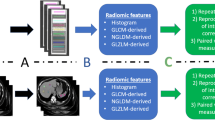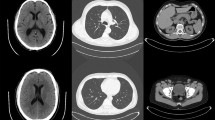Abstract
Background
The aim of this work was to assess the robustness of cardiac SPECT radiomic features against changes in imaging settings, including acquisition, and reconstruction parameters.
Methods
Four commercial SPECT and SPECT/CT cameras were used to acquire images of a static cardiac phantom mimicking typical myorcardial perfusion imaging using 185 MBq of 99mTc. The effects of different image acquisition and reconstruction parameters, including number of views, view matrix size, attenuation correction, as well as image reconstruction related parameters (algorithm, number of iterations, number of subsets, type of post-reconstruction filter, and its associated parameters, including filter order and cut-off frequency) were studied. In total, 5,063 transverse views were reconstructed by varying the aforementioned factors. Eighty-seven radiomic features including first-, second-, and high-order textures were extracted from these images. To assess reproducibility and repeatability, the coefficient of variation (COV), as a widely adopted metric, was measured for each of the radiomic features over the different imaging settings.
Results
The Inverse Difference Moment Normalized (IDMN) and Inverse Difference Normalized (IDN) features from the Gray Level Co-occurrence Matrix (GLCM), Run Percentage (RP) from the Gray Level Co-occurrence Matrix (GLRLM), Zone Entropy (ZE) from the Gray Level Size Zone Matrix (GLSZM), and Dependence Entropy (DE) from the Gray Level Dependence Matrix (GLDM) feature sets were the only features that exhibited high reproducibility (COV ≤ 5%) against changes in all imaging settings. In addition, Large Area Low Gray Level Emphasis (LALGLE), Small Area Low Gray Level Emphasis (SALGLE) and Low Gray Level Zone Emphasis (LGLZE) from GLSZM, and Small Dependence Low Gray Level Emphasis (SDLGLE) from GLDM feature sets turned out to be less reproducible (COV > 20%) against changes in imaging settings. The GLRLM (31.88%) and GLDM feature set (54.2%) had the highest (COV < 5%) and lowest (COV > 20%) number of the reproducible features, respectively. Matrix size had the largest impact on feature variability as most of the features were not repeatable when matrix size was modified with 82.8% of them having a COV > 20%.
Conclusion
The repeatability and reproducibility of SPECT/CT cardiac radiomic features under different imaging settings is feature-dependent. Different image acquisition and reconstruction protocols have variable effects on radiomic features. The radiomic features exhibiting low COV are potential candidates for future clinical studies.







Similar content being viewed by others
Abbreviations
- SPECT:
-
Single-photon emission computed tomography
- COV:
-
Coefficient of variation
- GLCM:
-
Gray level co-occurrence matrix
- GLRLM:
-
Gray level co-occurrence matrix
- GLSZM:
-
Gray level size zone matrix
- GLDM:
-
Gray level dependence matrix
- IDMN:
-
Inverse difference moment normalized
- LALGLE:
-
Large area low gray level emphasis
- SALGLE:
-
Small area low gray level emphasis
- SDLGLE:
-
Small dependence low gray level emphasis
References
Bauer UE, Briss PA, Goodman RA, Bowman BA. Prevention of chronic disease in the 21st century: Elimination of the leading preventable causes of premature death and disability in the USA. Lancet 2014;384:45-52.
Greenland P, Alpert JS, Beller GA, Benjamin EJ, Budoff MJ, Fayad ZA, et al. 2010 ACCF/AHA guideline for assessment of cardiovascular risk in asymptomatic adults: A report of the American College of Cardiology Foundation/American Heart Association Task Force on Practice Guidelines. J Am Coll Cardiol 2010;56:e50-103.
Slomka P, Hung GU, Germano G, Berman DS. Novel SPECT technologies and approaches in cardiac imaging. Cardiovasc Innov Appl 2016;2:31-46.
Abdollahi H, Shiri I, Salimi Y, Sarebani M, Mehdinia R, Deevband MR, et al. Radiation dose in cardiac SPECT/CT: An estimation of SSDE and effective dose. Eur J Radiol 2016;85:2257-61.
Juan Ramon A, Yang Y, Wernick MN, Pretorius PH, Johnson KL, Slomka PJ, et al. Evaluation of the effect of reducing administered activity on assessment of function in cardiac gated SPECT. J Nucl Cardiol 2019. https://doi.org/10.1007/s12350-018-01505-x.
Zaidi H. Quantitative SPECT: Recent developments in detector response, attenuation and scatter correction techniques. Phys Med 1996;12:101-17.
Watson DD. Quantitative SPECT techniques. Semin Nucl Med 1999;29:192-203.
Lambin P, Leijenaar RTH, Deist TM, Peerlings J, de Jong EEC, van Timmeren J, et al. Radiomics: The bridge between medical imaging and personalized medicine. Nat Rev Clin Oncol 2017;14:749-62.
Abdollahi H, Mostafaei S, Cheraghi S, Shiri I, Rabi Mahdavi S, Kazemnejad A. Cochlea CT radiomics predicts chemoradiotherapy induced sensorineural hearing loss in head and neck cancer patients: A machine learning and multi-variable modelling study. Phys Med 2018;45:192-7.
Al-Mallah MH. Radiomics in hypertrophic cardiomyopathy: The new tool. JACC Cardiovascular imaging 2019;12:1955-7.
Kolossvary M, De Cecco CN, Feuchtner G, Maurovich-Horvat P. Advanced atherosclerosis imaging by CT: Radiomics, machine learning and deep learning. J Cardiovasc Comput Tomogr 2019;13(5):274-80.
Kolossváry M, Maurovich-Horvat P. Cardiac CT radiomics. In: Schoepf UJ, editor. CT of the Heart. Totowa, NJ: Humana Press; 2019. p. 715-24.
Reuze S, Schernberg A, Orlhac F, Sun R, Chargari C, Dercle L, et al. Radiomics in nuclear medicine applied to radiation therapy: Methods, pitfalls, and challenges. Int J Radiat Oncol Biol Phys 2018;102:1117-42.
Gillies RJ, Kinahan PE, Hricak H. Radiomics: Images are more than pictures. They are data. Radiology 2016;278:563-77.
Rahmim A, Huang P, Shenkov N, Fotouhi S, Davoodi-Bojd E, Lu L, et al. Improved prediction of outcome in Parkinson’s disease using radiomics analysis of longitudinal DAT SPECT images. Neuroimage Clin 2017;16:539-44.
Shiiba T, Arimura Y, Nagano M, Takahashi T, Takaki A. Improvement of classification performance of Parkinson’s disease using shape features for machine learning on dopamine transporter single photon emission computed tomography. PLOS ONE 2020;15:e0228289.
Hajianfar G, Shiri I, Maleki H, Oveisi N, Haghparast A, Abdollahi H, et al. Noninvasive O6 methylguanine-DNA methyltransferase status prediction in glioblastoma multiforme cancer using magnetic resonance imaging radiomics features: Univariate and multivariate radiogenomics analysis. World Neurosurg 2019;132:e140-61.
Ashrafinia S, Dalaie P, Yan R, Ghazi P, Marcus C, Taghipour M, et al. Radiomics analysis of clinical myocardial perfusion SPECT to predict coronary artery calcification. J Nucl Med 2018;59:512.
Ashrafinia S, Dalaie P, Yan R, Huang P, Pomper M, Schindler T, et al. Application of texture and radiomics analysis to clinical myocardial perfusion SPECT imaging [Abstract]. J Nucl Med 2018;59:94.
Kolossváry M, Karády J, Szilveszter B, Kitslaar P, Hoffmann U, Merkely B, et al. Radiomic features are superior to conventional quantitative computed tomographic metrics to identify coronary plaques with napkin-ring sign. Circ Cardiovasc Imaging 2017;10:e006843.
Neisius U, El-Rewaidy H, Nakamori S, Rodriguez J, Manning WJ, Nezafat R. Radiomic analysis of myocardial native T1 imaging discriminates between hypertensive heart disease and hypertrophic cardiomyopathy. JACC Cardiovasc Imaging 2019;12:1946-54.
Ashrafinia S. Quantitative nuclear medicine imaging using advanced image reconstruction and radiomics. Baltimore: Johns Hopkins University; 2019.
Ashrafinia S, Dalaie P, Sadaghiani MS, Schindler T, Pomper M, Rahmim A. Standardized Radiomics of clinical myocardial perfusion stress SPECT images to determine coronary artery calcification score. Eur J Nucl Med Mol Imaging 2019;46:S17-8.
Motwani M. Hiding beyond plain sight: Textural analysis of positron emission tomography to identify high-risk plaques in carotid atherosclerosis. J Nucl Cardiol 2019. https://doi.org/10.1007/s12350-019-01981-9.
Hatt M, Tixier F, Pierce L, Kinahan PE, Le Rest CC, Visvikis D. Characterization of PET/CT images using texture analysis: the past, the present… any future? Eur J Nucl Med Mol Imaging 2017;44:151-65.
Zwanenburg A, Leger S, Vallières M, Löck S. Image biomarker standardisation initiative. arXiv preprint arXiv:161207003; 2016.
Traverso A, Wee L, Dekker A, Gillies R. Repeatability and reproducibility of radiomic features: A systematic review. Int J Radiat Oncol Biol Phys 2018;102:1143-58.
Kalendralis P, Traverso A, Shi Z, Zhovannik I, Monshouwer R, Starmans MPA, et al. Multicenter CT phantoms public dataset for radiomics reproducibility tests. Med Phys 2019;46:1512-8.
Pfaehler E, Beukinga RJ, de Jong JR, Slart R, Slump CH, Dierckx R, et al. Repeatability of (18) F-FDG PET radiomic features: A phantom study to explore sensitivity to image reconstruction settings, noise, and delineation method. Med Phys 2019;46:665-78.
Shiri I, Rahmim A, Ghaffarian P, Geramifar P, Abdollahi H, Bitarafan-Rajabi A. The impact of image reconstruction settings on 18F-FDG PET radiomic features: Multi-scanner phantom and patient studies. Eur Radiol 2017;27:4498-509.
Raunig DL, McShane LM, Pennello G, Gatsonis C, Carson PL, Voyvodic JT, et al. Quantitative imaging biomarkers: A review of statistical methods for technical performance assessment. Stat Methods Med Res 2015;24:27-67.
Fedorov A, Beichel R, Kalpathy-Cramer J, Finet J, Fillion-Robin J-C, Pujol S, et al. 3D Slicer as an image computing platform for the Quantitative Imaging Network. Magn Reson Imaging 2012;30:1323-41.
Van Griethuysen JJ, Fedorov A, Parmar C, Hosny A, Aucoin N, Narayan V, et al. Computational radiomics system to decode the radiographic phenotype. Cancer Res 2017;77:e104-7.
Yan J, Chu-Shern JL, Loi HY, Khor LK, Sinha AK, Quek ST, et al. Impact of image reconstruction settings on texture features in 18F-FDG PET. J Nucl Med 2015;56:1667-73.
Buvat I, Orlhac F. The dark side of radiomics: On the paramount importance of publishing negative results. J Nucl Med 2019;60:1543-4.
Kolossváry M, Karády J, Kikuchi Y, Ivanov A, Schlett CL, Lu MT, et al. Radiomics versus visual and histogram-based assessment to identify atheromatous lesions at coronary CT angiography: An ex vivo study. Radiology 2019;293:89-96.
Arad Y, Goodman KJ, Roth M, Newstein D, Guerci AD. Coronary calcification, coronary disease risk factors, C-reactive protein, and atherosclerotic cardiovascular disease events: The St. Francis Heart Study. J Am Coll Cardiol 2005;46:158-65.
Haberl R, Becker A, Leber A, Knez A, Becker C, Lang C, et al. Correlation of coronary calcification and angiographically documented stenoses in patients with suspected coronary artery disease: Results of 1,764 patients. J Am Coll Cardiol 2001;37:451-7.
Berman DS, Wong ND, Gransar H, Miranda-Peats R, Dahlbeck J, Hayes SW, et al. Relationship between stress-induced myocardial ischemia and atherosclerosis measured by coronary calcium tomography. J Am Coll Cardiol 2004;44:923-30.
He Z-X, Hedrick TD, Pratt CM, Verani MS, Aquino V, Roberts R, et al. Severity of coronary artery calcification by electron beam computed tomography predicts silent myocardial ischemia. Circulation 2000;101:244-51.
Abdollahi H, Shiri I, Heydari M. Medical imaging technologists in radiomics era: An alice in wonderland problem. Iran J Public Health. 2019;48:184.
Acknowledgments
This work was supported by the Swiss National Science Foundation under grant SNFN 320030_176052.
Disclosure
Mohammad Edalat-Javid, Isaac Shiri, Ghasem Hajianfar, Hamid Abdollahi, Hossein Arabi, Niki Oveisi, Mohammad Javadian, Mojtaba Shamsaei Zafarghandi, Hadi Malek, Ahmad Bitarafan-Rajabi, Mehrdad Oveisi, and Habib Zaidi declare that they have no conflict of interest.
Author information
Authors and Affiliations
Corresponding author
Additional information
Publisher's Note
Springer Nature remains neutral with regard to jurisdictional claims in published maps and institutional affiliations.
The authors of this article have provided a PowerPoint file, available for download at SpringerLink, which summarizes the contents of the paper and is free for re-use at meetings and presentations. Search for the article DOI on SpringerLink.com.”
Electronic supplementary material
Below is the link to the electronic supplementary material.
Rights and permissions
About this article
Cite this article
Edalat-Javid, M., Shiri, I., Hajianfar, G. et al. Cardiac SPECT radiomic features repeatability and reproducibility: A multi-scanner phantom study. J. Nucl. Cardiol. 28, 2730–2744 (2021). https://doi.org/10.1007/s12350-020-02109-0
Received:
Accepted:
Published:
Issue Date:
DOI: https://doi.org/10.1007/s12350-020-02109-0




